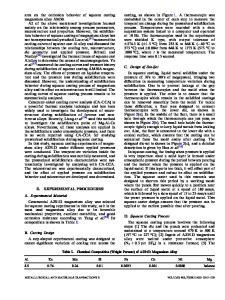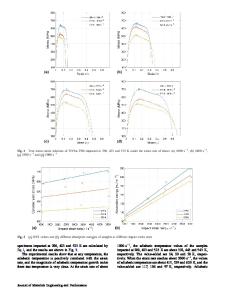Effect of Strain Rate and Temperature on Fracture and Microstructure Evolution of AZ91D Magnesium Alloy Processed by Las
- PDF / 5,999,570 Bytes
- 13 Pages / 593.972 x 792 pts Page_size
- 83 Downloads / 310 Views
INTRODUCTION
BECAUSE of their low density and high specific strength, magnesium alloys have potential application value in components where energy conservation and emission reduction are desired, such as automotive, railway, and aerospace industries.[1,2] However, their low strength at elevated temperatures is one of the factors that hinder their application in high-temperature components.[3] How to improve high-temperature strength has always been one of the problems of concern to material researchers. Adding earth elements can improve high-temperature strength,[4–7] but doing so is commonly at the cost of greatly increasing the production expense.[8] Developing composite materials is another way to improve high-temperature strength,[9–12] but these also substantially increase production cost. In addition, nanoparticles,[13] carbon nanotubes,[14] and graphene nanoplatelets[15] have also been used to CHAO MENG, HAINING YANG, GANG LIA, and XUELEI WANG are with the School of Materials Science and Engineering, Liaoning Technical University, Fuxin 123000, China. Contact e-mail: [email protected] ZHIKAI CHEN is with The Academy of Xuzhou Construction Machinery, Xuzhou Construction Machinery Group, Xuzhou 221004, China. HENG BAO is with the Security Department of 9588 Troops, No. 1827 Yingbin Road, Changchun 130062, China. Manuscript submitted December 23, 2017.
METALLURGICAL AND MATERIALS TRANSACTIONS A
improve high-temperature properties, but these methods have less to do with increasing high-temperature strength than increasing strength at room temperature (RT) and superplastic behavior at elevated temperatures. Laser surface melting (LSM) is regarded as one of the most effective techniques for improving wear,[16–18] corrosion,[19–23] and mechanical properties[24,25] of metal parts because the microstructure of the laser-treated zone can be homogenized and refined. In recent years, some researchers[26–31] have developed a new LSM processing method that is a selective treatment on the surfaces of materials instead of bulk treatment. Wang et al.[29,30] reported that microstructure transformation, different surface shape, and distribution spacing of steel processed by LSM are responsible for improved strength and toughness at RT. Zhang et al.[31] investigated thermal fatigue behavior of the Mg-9Al-Zn alloy with striation shape that was processed by LSM and proposed that the thermal fatigue property is enhanced as a consequence of homogenized and refined microstructure as well as dissolved second phases of the material. It can be seen from these results that selective LSM treatment on the surfaces of magnesium alloys is a potential way to increase high-temperature strength. However, study of selective LSM treatment method for improving high-temperature mechanical properties of magnesium alloys has rarely been reported in recent years. Meng et al.[32] reported that selective LSM treatment improved
the high-temperature strength of the AZ91D magnesium alloy. However, the strain rate, which has a very important impact on def
Data Loading...











